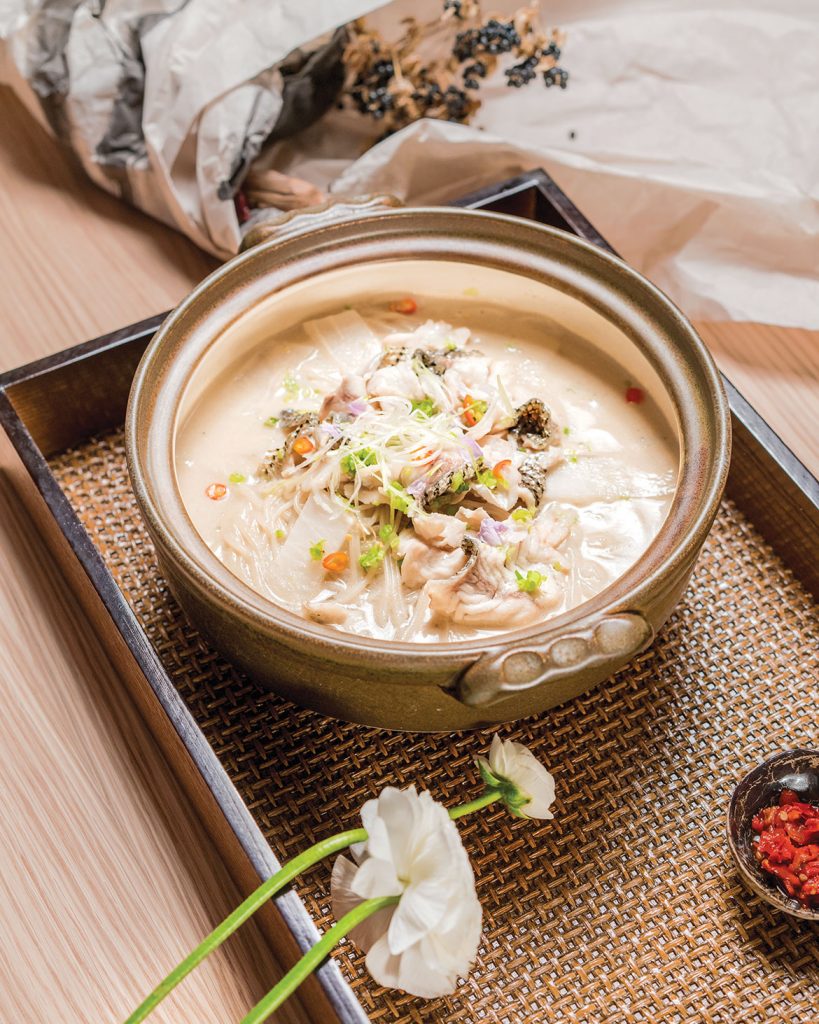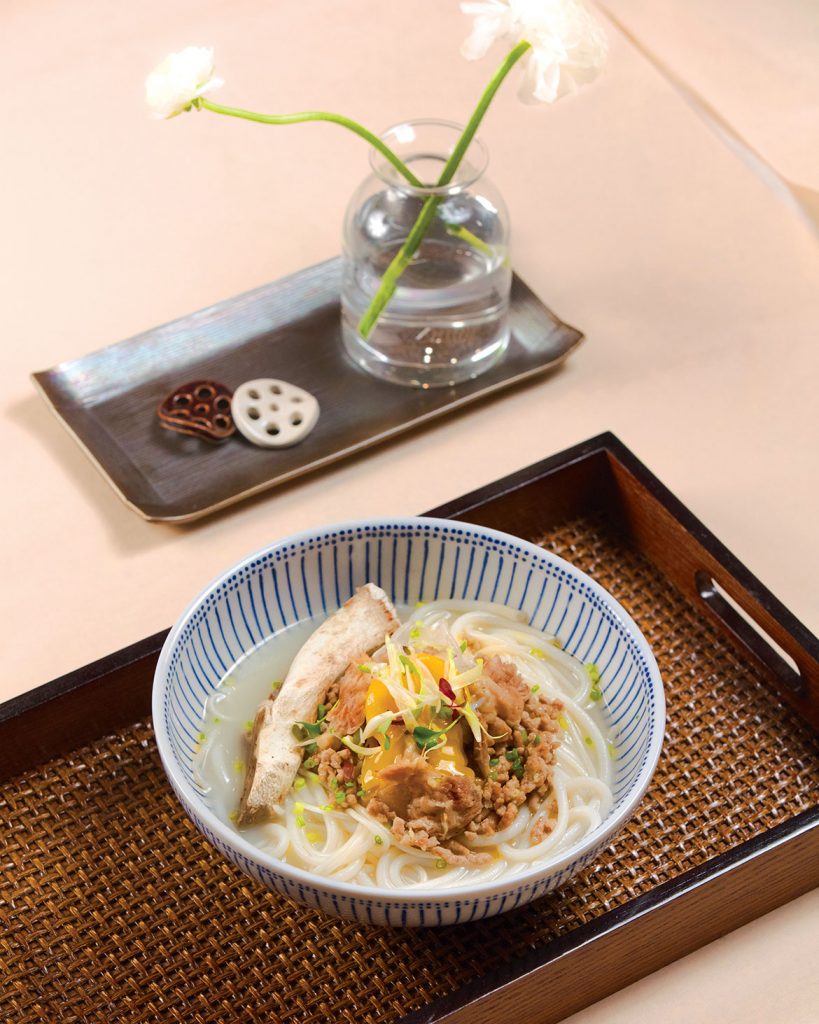By Loannie Dao
Contemporary Chinese eateries are sprouting up all over Manhattan and Hunan Slup is the newest on the scene. Chef Chao Wang opened the doors to the restaurant this past spring in the hopes of bringing his hometown flavors to New York’s East Village.
The restaurant occupies the first floor of a classic five-story mixed-use East Village building. Years of change and turnover have transformed the neighborhood into the center of New York’s vibrant counterculture. The East Village is known as the birthplace and historical home of many artistic movements. So, it comes as no surprise that Chef Wang established Hunan Slurp in this bustling community.
Chef Wang was born in Hengyang, Hunan (the second largest city of Hunan Province, China). Although his lineage boasts a long line of restaurant owners, the most influential was his grandparents’ generation. His cooking style is heavily swayed by his grandmother, who he still consults with on traditional Hunan cuisine to this day.
 Chef Wang has also had a long career in the arts, graduating from China Central Academy of Fine Arts. He went on to complete a Masters in Fine Art at New York Academy of Art and has since worked with notable Chinese and American artists. Before opening his restaurant, Chef Wang spent 25 years as a classically trained oil painter. And for Chef Wang, the dishes at Hunan Slurp are an extension of his art and love for food, blended into a finely garnished masterpiece. Through his artistic interpretation of traditional Hunan dishes, every plate is meticulously designed to please the eye every bit as much as the taste buds.
Chef Wang has also had a long career in the arts, graduating from China Central Academy of Fine Arts. He went on to complete a Masters in Fine Art at New York Academy of Art and has since worked with notable Chinese and American artists. Before opening his restaurant, Chef Wang spent 25 years as a classically trained oil painter. And for Chef Wang, the dishes at Hunan Slurp are an extension of his art and love for food, blended into a finely garnished masterpiece. Through his artistic interpretation of traditional Hunan dishes, every plate is meticulously designed to please the eye every bit as much as the taste buds.
Chef Wang credits his artistic skills for having afforded him the ability to see dishes in a three-dimensional light. As a result, the food is plated masterfully. His liberal use of red chili peppers, shallots, and garlic embellish every plate. Hunan Slurp, of course, is best known for its rice noodle dishes that are accompanied with hot and spicy flavors, rich aromas, and decadent colors.
Some classic dishes from Chef Wang’s hometown, such as the Fish Fillet Mifen, have found their way onto the menu. Served in a traditional clay pot, the soup is offered with a side of noodles. For this dish, the pork bone broth is simmered overnight then boiled on low heat until the lucid base turns milky white. It is then topped with wok-fried fish and pickled vegetables to bring out its unique flavor.
Another popular item on the menu is the Three Delicacies Mifen. This is a family recipe passed down to Chef Wang and the dish features an assortment of soft eggs (made by carefully rolling together several layers of steamed egg), oyster mushrooms (providing a mild flavor with a velvety texture), and thinly-sliced pork. Similar to most plates, the course is complemented by earthy vegetables and silky rice noodles.
 Reminiscent of his grandmother’s cooking, the Classic Chicken dish brings Chef Wang back to when he used to visit his grandmother at her home in the countryside. This dish is served with organic, free-range chicken that is stir-fried in rice wine sauce. Every bite is balanced with mushrooms, peppers, and a touch of celery. The authentic flavors of this dish remind Chef Wang of his childhood in Hunan.
Reminiscent of his grandmother’s cooking, the Classic Chicken dish brings Chef Wang back to when he used to visit his grandmother at her home in the countryside. This dish is served with organic, free-range chicken that is stir-fried in rice wine sauce. Every bite is balanced with mushrooms, peppers, and a touch of celery. The authentic flavors of this dish remind Chef Wang of his childhood in Hunan.
With nutty cumin and citrusy lemongrass, the Skewed Beef is served in a generous heap of toothpick-sized bites. Like many dishes on the menu, it is loaded with chopped red chili peppers, sesame seeds, and scallions which bring out its smoky flavors. The special seasoning mix was created by the Hunan people to counter the heavy humidity of the region.
When it comes to the Hunan Slurp’s design, it breaks free of the overcrowded tables, clanging dishes, and overzealous cooks of the stereotypical Chinese restaurant. The interior space engages with the robust streets of the East Village and honors the sophistication of each dish. The contemporary space is designed by the New York-based firm, New Practice Studio. The first thing pedestrians passing the storefront will notice is a crowd of people slurping on generous portions of Hunan rice noodle dishes. This design transports visitors into the restaurant through a large glass window that spans the length of the building’s narrow façade.
Inside, the wood-lined archways mimic the shape and color of rice noodles. This woodwork frame serves as a sort of geometric screen, and is illuminated by warm undertones from backlighting and lighting fixtures. These fixtures, including large exposed bulbs, provide both an intimate and social dining setting for the restaurant’s single and communal tables. And while being seated at the front of Hunan Slurp ensures a connection to the lively East Village vibe, diners seated in the space’s back have a view into the kitchen. The restaurant fills just 3,000 square feet in total, but overall, it is a true image of hungry New York.
 To Chef Wang, food is an eloquent expression of his family’s heritage. As he recalls, “We wake up to the slurping sound from rice noodle shops in little alleyways and go to bed with warm rice noodle soup in our stomachs after night-longs of drinking and chatting. This custom defines us, the people of Hunan.” Leaning heavily on the nuances of tradition, Hunan Slurp earns the designation as one of the East Village’s most authentic Hunan cuisine establishments.
To Chef Wang, food is an eloquent expression of his family’s heritage. As he recalls, “We wake up to the slurping sound from rice noodle shops in little alleyways and go to bed with warm rice noodle soup in our stomachs after night-longs of drinking and chatting. This custom defines us, the people of Hunan.” Leaning heavily on the nuances of tradition, Hunan Slurp earns the designation as one of the East Village’s most authentic Hunan cuisine establishments.






